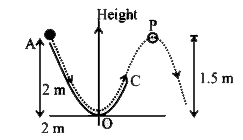Assertion:- The heavier P-block elements form storng π− bonds.
Reasons:- The heavier elements of p-block form dπ−pπ or dπ−dπ bonds.
The correct Answer is:A
To analyze the assertion and reason provided in the question, we will break down the concepts related to the bonding in heavier p-block elements step by step.
Step 1: Understanding the Assertion
The assertion states that "The heavier P-block elements form strong π bonds."
- Explanation: Heavier p-block elements, such as sulfur, selenium, and tellurium, have the ability to form π bonds. However, the strength of these π bonds can vary based on the type of orbital overlap involved.
Step 2: Understanding the Reason
The reason states that "The heavier elements of p-block form dπ−pπ or dπ−dπ bonds."
- Explanation: In heavier p-block elements, there are available d-orbitals that can participate in bonding. This allows for the formation of dπ−pπ and dπ−dπ bonds, which are different from the pπ−pπ bonds formed by lighter p-block elements like oxygen.
Step 3: Comparing Bond Strengths
Now, we need to compare the strength of these different types of bonds.
- Bond Strength:
- pπ−pπ bonds (formed by lighter elements) are generally stronger due to better overlap between the p-orbitals.
- dπ−pπ and dπ−dπ bonds (formed by heavier elements) are generally weaker because the overlap between d-orbitals and p-orbitals is not as effective as that between p-orbitals.
Step 4: Conclusion
Based on the analysis:
- The assertion that heavier p-block elements form strong π bonds is false.
- The reason that heavier elements of the p-block form dπ−pπ or dπ−dπ bonds is true.
Thus, the final conclusion is:
- Assertion is false; Reason is true.
Summary of the Solution
1. The assertion is incorrect because heavier p-block elements do not form strong π bonds.
2. The reason is correct as it explains the type of bonds formed by heavier p-block elements.
The assertion states that "The heavier P-block elements form strong π bonds."
The reason states that "The heavier elements of p-block form dπ−pπ or dπ−dπ bonds."
Now, we need to compare the strength of these different types of bonds.
- pπ−pπ bonds (formed by lighter elements) are generally stronger due to better overlap between the p-orbitals.
- dπ−pπ and dπ−dπ bonds (formed by heavier elements) are generally weaker because the overlap between d-orbitals and p-orbitals is not as effective as that between p-orbitals.
Based on the analysis:
- The assertion that heavier p-block elements form strong π bonds is false.
- The reason that heavier elements of the p-block form dπ−pπ or dπ−dπ bonds is true.
- Assertion is false; Reason is true.
1. The assertion is incorrect because heavier p-block elements do not form strong π bonds.
2. The reason is correct as it explains the type of bonds formed by heavier p-block elements.
Topper's Solved these Questions
- THE P-BLOCK ELEMENTSBOOK - NCERT FINGERTPS ENGLISHCHAPTER - THE P-BLOCK ELEMENTSEXERCISE - Group 13 Elements - The Boron Family
23 Videos
- THE P-BLOCK ELEMENTSBOOK - NCERT FINGERTPS ENGLISHCHAPTER - THE P-BLOCK ELEMENTSEXERCISE - Important Trends And Anomalous Properties Of Boron
4 Videos
- THE P-BLOCK ELEMENTSBOOK - NCERT FINGERTPS ENGLISHCHAPTER - THE P-BLOCK ELEMENTSEXERCISE - EXEMPLAR PROBLEMS
15 Videos
- STRUCTURE OF ATOM BOOK - NCERT FINGERTPS ENGLISHCHAPTER - STRUCTURE OF ATOM EXERCISE - Assertion And Reason
15 Videos
- THE S-BLOCK ELEMENTSBOOK - NCERT FINGERTPS ENGLISHCHAPTER - THE S-BLOCK ELEMENTSEXERCISE - Assertion And Reason
15 Videos
Similar Questions
The pair of elements which form ionic bond is .
View SolutionThe ability of d-block elements to form complexes is due to:
View Solutionp block elements of 6th period are represented as :-
View Solutiondπ=pπ bond present in:
View SolutionWhich of the following elements form pπ−dπ bonding in its oxide ?
View Solutiondπ−pπ bond is present in :
View SolutionA particle (m = 3 kg) slides down a frictionless track (AOC) starting from rest at a point A (height 2m). After reaching C, the particle continues to move freely in air as a projectile. When it reaching its highest point P (height 1.5 m) the kinetic energy of the prarticle (in J) is : Figure drawn is schematic and not to scale , take g = 10ms−2

View SolutionThe element which belong with p-block is/are
View SolutionGive two characteristics of p-block elements.
View SolutionThe transition elements are more metallic then p - block elements because they have
View Solution
